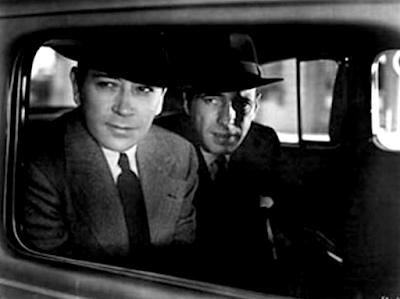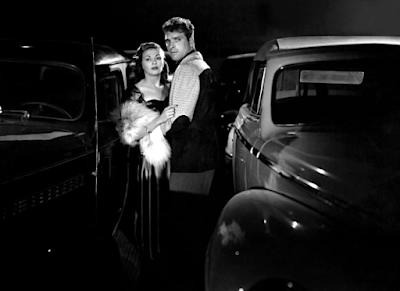 |
| Lucille Ball, Mark Stevens, 'The Dark Corner' (1946). |
By Paul Parcellin
Mark Stevens made a string of taut crime dramas in the 1940s and ’50s that still resonate today. He acted in dozens of films, from westerns, war pictures to musicals and comedies, and directed two of his self-produced noirs as well as some hardboiled television series.
Born Richard William Stevens in 1916, he adopted "Mark" as his show business handle after Daryl Zanuck suggested he take on Dana Andrews’s character's name in “Laura.” His family lived briefly in Cleveland before his parents divorced and his mother brought him to England. She remarried and they settled in Montreal.
A devastating injury
In his youth Stevens distinguished himself in competitive swimming and diving until he severely injured his back in a diving accident. He endured a number of surgeries that eventually returned him to normal mobility but his injury kept him out of the service. While convalescing he frequented movie houses and developed a love of cinema.
His first acting roles were in community theater and he later performed with a stock theater company. Setting his sights on the big time, he moved to New York but fell upon hard times and returned home to Montreal. He saved his pennies and bought a train ticket to California where Warner Brothers eventually gave him a screen test and made him a contract player.
On the screen, then out the door
He appeared in “Destination Tokyo” (1943) with Cary Grant and John Garfield, and “Objective, Burma” (1945) with Errol Flynn. After two years of bit roles he complained to the studio’s top dog Jack Warner that his career wasn’t advancing as quickly as he’d like. Warner rebuffed him, and in protest Stevens played hooky from his job, after which the studio dropped him.But as one door slammed shut another opened at 20th Century Fox, where among other projects, he acted in a pair of solid noirs, “The Dark Corner” (1946), and “The Street with No Name” (1948).
A promising start with Fox
Eager to capitalize on the surprise hit, “Laura” (1944), Fox assembled a similar array of characters for “The Dark Corner” with Stevens in the role of Bradford Galt, an inexperienced yet somehow world-weary and cynical private eye. His recent hire, secretary Kathleen Stewart (Lucille Ball), is perky, wise cracking and street smart — just the kind of gal for Galt. Five years before her “I Love Lucy” debut, Ball gives us a taste of her acting chops and a touch of slapstick comedy — keep an eye out for the scene in which when she swings wildly in a batters cage.
The story gets cracking when Galt slaps around a mug in a white linen suit (William Bendix) who’s been tailing him. Of course, that’s not the last he sees of Bendix, who turns in his signature tough guy performance.
Different story, familiar characters
The story revolves around effete art dealer Hardy Cathcart (Clifton Webb), Galt’s former partner, Tony Jardine (Kurt Kreuger), and Cathcart’s wife, Mari (Cathy Downs). Webb is virtually repeating his role as acid-tongued gossip columnist Waldo Lydecker in “Laura.” Alas, Ball, Webb and Bendix steal every scene they’re in, but Stevens still makes a strong enough, if not stellar, showing as the jaded shamus.
Top of the heap, at last
He finally gets top billing in “The Street with No Name,” but, once again Stevens is both blessed and cursed to appear alongside co-star Richard Widmark. Widmark’s on-screen charisma is like a blindingly brilliant light that leaves Stevens’s solid performance a bit in the shadows.
 |
| Richard Widmark, "The Street with No Name" (1948). |
G-man goes undercover
In “The Street with No Name” FBI agent Gene Cordell (Stevens) infiltrates a vicious gang operating in a seedy anywhere-America city. Head crook Alec Stiles (Widmark) runs a boxing gym and commands a band of robbers. Lloyd Nolan plays the same FBI Inspector Briggs of “The House on 92nd Street” (1945) and Ed Begley is the police chief.
The film’s stunning look, crafted by cinematographer Joseph MacDonald, creates shadowy dive hotel rooms, dark, forbidding alleyways and menacing skid row streets with astonishing artistry.
Gunplay and fisticuffs
It’s a tight action drama with a slug-fest boxing match and a noir shootout, appropriately, in a gloomy factory. Unfortunately, Stevens apparently didn’t live up to Fox’s expectations of a leading man and loan-outs to other studios began until his contract lapsed.
After Fox, he found work with the “three little majors,” Universal, Columbia and United Artists, and with low-budget B-movie factories on Poverty Row. Most notably he appeared in a noir for Columbia, “Between Midnight and Dawn” (1950), with Edmond O’Brien, in which he plays a rookie cop paired with O’Brien, patrolling city streets on the graveyard shift.
 |
| Mark Stevens, Edmond O'Brien, "Between Midnight and Dawn" (1950). |
Cops in a radio car
The film is a police procedural wrapped around a buddy movie with a documentary style opening. The film’s staccato newsreel-like footage gives way to a smoother paced story of police officers trying to tame the influence of organized crime in their city. A sub-plot offers some rickety comedy involving Stevens’s Rocky Barnes awkwardly wooing police radio dispatcher Katherine Mallory (Gale Storm). The light humor seems inconsequential, but Katherine becomes more significant to the film’s emotional backbone in the later part of the story.
The green and the disillusioned
O’Brien’s Patrolman Daniel Purvis is street smart and cynical, while Barnes is as yet unscathed by bitter experience on the force. When the crime fighting duo arrest racketeer Ritchie Garris (Donald Buka) things get serious and a revenge drama is set in motion. The cast turns in solid performances all around as the film comes to a tense climax.
After “Between Midnight and Dawn,” television roles followed for Stevens. In 1953 he took over the lead role in NBC-TV’s detective drama “Martin Kane.” He stayed with the show just one season, 40 episodes, but it provided him the security of a steady paycheck as he made plans for the future.
 |
| Mark Stevens, Trudy Wroe, "Big Town" (1954). |
A leap into ‘Big Town’
It was a big risk, but the following year Stevens bought a half-stake in the TV series “Big Town” (1950-1956). The series, which ran on CBS (1950-1954) and NBC (1954-1956), is built around a crusading news reporter fighting corruption. Stevens appeared in 82 episodes. In his second season he began writing, directing and producing episodes, which would prove to be a key to his later success in film and television.
Out for revenge
Back on the big screen, Stevens directed and starred in “Cry Vengeance” (1954), a revenge thriller he made for Allied Artists, formerly Monogram Pictures. In it, San Francisco ex-cop Vic Barron (Stevens) is haunted by his past. He crossed mobster Tino Morelli (Douglas Kennedy) and soon thereafter his family was killed in a car bombing that left him disfigured. The mobster framed him for a crime he didn’t commit and Barron served three years in prison.
We meet him as he’s released from lockup and filled with a desire for vengeance on Morelli. But is he after the right man? Barron’s search for the culprit brings him all the way to Alaska, but finding the perpetrator behind the bombing proves more complicated than he anticipated.
 |
| Mark Stevens, "Cry Vengeance" (1954). |
A company of his own
Following “Cry Vengeance, he formed Mark Stevens Productions in 1955 with ambitious plans for films and TV series as well as an expansion into the music publishing and record distribution businesses. Most of these ventures didn’t pan out, with the exception of the noir “Time Table” (1956). This time, Stevens directs and stars, playing insurance cop Charlie Norman who is assigned to investigate a train heist that turns out to be more than what meets the eye.
Robbery on the rails
The gang pulls off a complicated railway robbery that depends on adherence to a strict timetable — if one move goes wrong a chain reaction would quash the caper. The film features a gripping 10 minute robbery sequence that showcases Stevens’s directing style. We learn about Charlie, who’s obsessed with status and material wealth. He’s jumpy and craves success — perhaps a bit like the real-life Stevens. He spells it all out in a short burst of anti-establishment dialogue: “For me, patience in poison!”
Just one film completed
The taut thriller would be Mark Stevens Productions’s lone completed project. It’s unclear what exactly brought about the company’s demise, although it’s likely that Stevens invested too heavily in his productions. “Time Table” stands as a shining example of Stevens’s craft (at times, he claimed the company produced others).
Off to distant shores
The production company’s failure was enough to make Stevens flee to Majorca, Spain, where he eventually retired. Throughout the late 1950s and 1960s he returned to the states periodically for TV guest spots, mostly on westerns. He appeared in “Fate is the Hunter” (1964) with Glenn Ford, and back on the continent he appeared in a string of forgettable European movies.
He popped up now and again in TV guest spots on “Kojack,” “Simon and Simon” and “Magnum, P.I.” His final TV appearance came in 1987. He died of cancer in 1994 at age 77.





















































